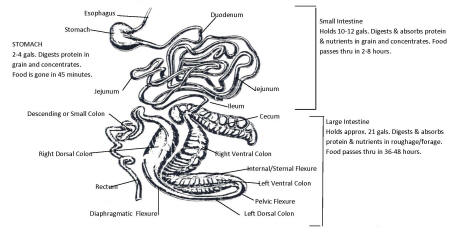|
BASICS OF EQUINE NUTRITION
Samantha Mixon, D.V.M.
Nutrition is an extremely important and complicated subject. It
is one which should be taken seriously because of the consequences
of poor nutrition and nutritional misinformation. It is critical for
the horse owner to understand how the equine gastrointestinal (G.I.)
tract is designed to function. Thus, he or she can make
well-informed decisions about all of the masses of accurate and
inaccurate information put out by the popular press. In this article
I hope to stress the major points of horse nutrition which can be
applied to any horse, and can be built upon for pregnant mares,
horses in heavy training or those with individual problems.
The diagram shows the different sections of the horse G.I . tract:
how much each section holds, what each section is designed to do,
and long ingesta (food), remains in each section.
The diagram illustrates one of the most overlooked, yet important
points about horses: THE HORSE IS DESIGNED TO EAT AND UTILIZE
ROUGHAGE. The stomach and small intestine, the area of the G.I.
tract that digests and absorbs nutrients from grain and concentrates
is very small in comparison to most mammals, and in comparison to
the horse’s large intestine. The time allowed for digestion and
absorption is also minimal (45 minutes) in the stomach and small
intestine. Once the grain and concentrates leave the stomach and
small intestine (S.I.) they are pure waste. The large Intestine (L.I.)
is designed for the roughage digestion and absorption.
The L.I. contains not only a much larger surface area, but has a
large natural flora (bacteria) population. This bacteria converts
many of the digestible nutrients in roughage to protein and vitamins
which are easily absorbed by the horse. The roughage or forage is
processed and used by the horse’s gut for 36-48 hours for maximum
benefit to the horse. Understanding these facts, common sense would
tell us that it is a mistake to spend more money on fancy grain
mixtures and less money on good quality hay.
FORAGE
Roughage (forage), is the foundation of a safe and successful
equine diet. Forages (legumes like alfalfa, grasses and cereal hays)
are extremely important feeds. First they provide nutrients
(protein, carbohydrates, fats and vitamins) needed in the form the
horse was designed to use. Secondly, forages continually stimulate
the muscle tone, and activity of the gut. Forage should make up AT
LEAST one-half of the total dry matter fed a day, or 1 lb. of hay to
100 lbs. of bodyweight daily. That translates into 10-12 lbs. of hay
daily for a 1,000-1,200 lb. horse. Feeding inadequate forage/hay to
a horse not on a good quality free choice pasture greatly increases
the risk of diarrhea, colic and founder. It also encourages abnormal
behavior such as wood chewing, tail chewing, mane chewing, and
copraphagia (eating their own manure). A wild horse, or one on
unlimited pasture will graze for 18-20 hours every day.
GRAIN
Grain or concentrates are not needed by many horses, all or the
majority of the time. Grain or concentrates should be fed:
1. When necessary to provide nutrients that are needed but are not
provided in adequate amounts by the forage consumed (most often this
is during growth, lactation, and intense training/use)
2. When good quality forages (hay) are not readily available or is
more expensive then grain.
3. When desired for other reasons, such as a treat, training, or
behavior modification aid such as to help catch horses.
Although horses can be gradually adapted to a diet that consists
entirely of cereal grain, the greater the proportion of grain in the
diet, the greater the risk of diarrhea, colic, acute laminitis or
founder, exertion myopathy, hyperactivity and obesity.
It is recommended by equine nutritionists that a grain or
concentrate mix not make up over 50% of the daily diet. This
translates into .7 lbs. grain/100 lbs. of bodyweight daily. The
percentage of protein in the grain mixes is also an area of concern.
Unless the horse is a lactating mare or a young horse in race
training, and a few other special situations, the percentage of
protein should not be higher than 10%! Since most horse owners do
feed a grain/concentrate of some kind, it is best to remember that
once these feeds leave the stomach and S.I. they are a waste. To get
the most benefit nutritionally and monetarily from the feed, smaller
more frequent meals (as opposed to just one feeding a day) will
increase the feed efficiency.
KEY POINTS
1. Water and forage are the two feeds required for life by all
horses.
2. The horse was designed to eat and digest roughage/forage for all
his protein, vitamins and minerals. (grass hay/alfalfa/cereal hay)
3. No magic diets or supplements exist that will help the horse more
than a good solid nutrition program based on facts not fiction.
4. The majority of horses should on a grain/concentrate that
contains 10% protein, no higher.
5. The closer the horse owner sticks to the natural diet of the
horse the less likely they will see man induced illnesses.
6. The horse was designed to eat and digest hay/forage for 18-20
hours in a 24 hour day for optimal health.
The research for this article was done by Lon D. Lewis, DVM, who
wrote Equine Clinical Nutrition and by Drs. Potter and Gibbs, both
of whom have done extensive nutrition studies on the horse at Texas
A & M University.
Click to see larger size.

back |